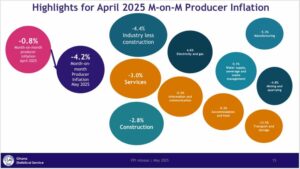… as industrial prices retreat
By Juliet ETEFE ([email protected])
The producer price inflation (PPI) saw a significant year-on-year (YoY) decline in May 2025, to 10.2 percent from 18.5 percent recorded in April, according to new data released by the Ghana Statistical Service (GSS).
This represents an 8.3 percentage point drop in the annual rate of increase in ex-factory prices received by domestic producers.
Driven primarily by developments in the industrial sector, it is also the fourth consecutive monthly drop in PPI and the lowest annual producer inflation rate recorded since November 2023 (1.7 percent).
Producer price inflation represents the rate at which prices received by domestic producers for their goods and services change.
The GSS attributed the decline to price movements within the Mining and Quarrying, and Manufacturing sectors, which together contributed over 78 percent to the overall PPI basket.
“The two most important contributors to the decline of producer price inflation in May 2025 were Mining and Quarrying (10.6 ppt) and Manufacturing (9.5 ppt), both accounting for 78.7 percent of PPI.
“Mining and Quarrying contributed 10.6 percentage points while Manufacturing added 9.5 percentage points to the PPI, but both sectors recorded significantly lower inflation figures in May,” the GSS stated.
The Mining and Quarrying sector, which holds the highest weight of 43.7 percent in the index, experienced a decline in inflation from 24.3 percent in April to 13.7 percent in May. Similarly, the Manufacturing sector’s inflation dropped from 19.6 percent to 10.1 percent over the same period.
Other sectors such as Electricity and Gas (8.9 percent) and Construction (7.4 percent) recorded relatively moderate annual inflation rates, while the Transportation and Storage sector experienced a decline of 4.8 percent. The Services sector as a whole contributed only 1.7 percent to overall producer inflation.

Month-on-month
On a month-on-month basis, May 2025 recorded producer deflation of 4.2 percent, indicating that producers, on average, received lower prices for their goods and services compared to April. This is also a steeper monthly decline than the 0.8 percent recorded in April.
The biggest contributors to the monthly decline were the Manufacturing sector (-5.3 percent) and Mining and Quarrying (-4.8 percent). Other sectors such as Transportation and Storage (-13.5 percent) and Accommodation and Food Services (-9.2 percebt) also posted sharp month-on-month declines, as downward pricing pressure occured across multiple industries.
Despite the widespread declines, Electricity and Gas saw a month-on-month increase of 4.6 percent, making it the only major sector to register a price increase during the month under review.
The GSS noted that while the decline in producer inflation may ease pressure on consumer prices in the near future, it could also signal tighter profit margins for businesses.
“Consumers may benefit in the coming months through a reduction in inflation if businesses pass on stability in prices. Producers and manufacturers may face tighter margins and more competition,” the Statistical Service indicated.
Businesses
In light of the current trends, the GSS recommends that businesses reassess their cost structures and consider sourcing more inputs locally to mitigate currency and import-related risks.
It also encouraged producers to re-engage financial partners under the more stable pricing environment to support investment and expansion efforts.
Gov’t
For government, the GSS advised fast-tracking strategic initiatives like the Gold Board and the Agriculture for Transformation Agenda to bolster economic stability and import substitution.
The Service also emphasised the need for sustained public education on the importance of producer inflation as a vital economic indicator and called for clearer communication of positive economic signals to reinforce confidence among businesses and households.
It noted that the overall economic outlook appears cautiously optimistic, with the persistent decline in producer inflation indicating a possible turning point in inflationary trajectory.










